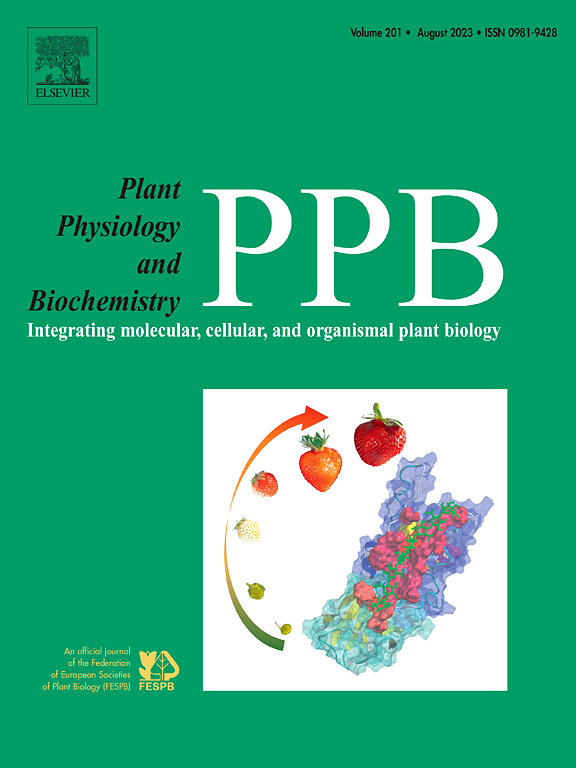Unveiling the role of cadaverine in mitigating salinity and/or Bisphenol A toxicity in tomato plants and reduced Bisphenol A accumulation in tomato roots
IF 6.1
2区 生物学
Q1 PLANT SCIENCES
引用次数: 0
Abstract
Mitigating the co-existence of environmental stresses on crop plants necessitates the development of integrated, eco-friendly, and sustainable approaches to alleviate plant stress responses. This study represents the first attempt to mitigate the toxic impact of prevalent pollutant (salinity) and an emergent plastic manufacturing pollutants (bisphenol A, BPA) using the polyamine (cadaverine).Tomato plants, treated with or without cadaverine, were subjected to NaCl salinity (120 mM), BPA (375 mg kg−1 soil), and their combinations compared to non-stressed control plants examining morphological, physiological, metabolic, and molecular responses. After 10 days of transplanting, tomato plants under combined stress were unable to survive without cadaverine application. However, cadaverine spraying mitigated the damaging effects of both single and combined stresses under short- and long-term exposure, enabling stressed plants to endure the conditions and complete their life cycles. Cadaverine efficiently restrained the reduction in chlorophylls, carotenoids, and cytosolutes under applied stresses compared to the stressed plants. Cadaverine also increased α-tocopherol content (by 171 and 53 %) and enhanced the activity of polyphenol oxidase (by 26 and 32 %), glutathione s-transferases (by 18 and 39 %), superoxide dismutase (by 23 and 46 %), and phenylalanine ammonia-lyase (by 9 and 25 %), under BPA and salinity stress, respectively. Thus, cadaverine ameliorated the oxidative and nitrosative burst induced by BPA or salinity, respectively by declining hydroxyl radical (by 28 % and 20 %), superoxide anion (by 73 % and 74 %), nitric oxide (by 60 and 65 %), lipid peroxidation (by 35 % and 54 %), and lipoxygenase activity (by 74 and 68 %). Moreover, cadaverine enhanced the expression of defence-related genes, including polyphenol oxidase, tubulin, and thaumatin-like protein, and reduced the uptake of BPA in the tomato's roots while promoting its metabolism in leaves and fruits. This ensured the safety of the harvested fruits. By mitigating stress, improving plant resilience, and limiting pollutant accumulation, cadaverine presents significant potential for sustainable agricultural practices and food safety. These findings offer valuable insights into the role of cadaverine in managing abiotic stress and safeguarding crop health in environmentally challenging conditions.

揭示尸胺在减轻番茄植株盐度和/或双酚A毒性以及减少番茄根系双酚A积累中的作用
要减轻环境压力对作物植物的并存影响,就必须开发综合、生态友好和可持续的方法来减轻植物的压力反应。这项研究首次尝试利用多胺(尸胺)来减轻普遍存在的污染物(盐度)和新出现的塑料制造污染物(双酚 A,BPA)的毒性影响。番茄植株经尸胺处理或不经尸胺处理后,受到氯化钠盐度(120 毫摩尔)、双酚 A(375 毫克/千克-1 土壤)及其组合的胁迫,并与未受胁迫的对照植株进行形态、生理、代谢和分子反应方面的比较。移栽 10 天后,如果不施用尸胺,番茄植株在综合胁迫下无法存活。然而,在短期和长期胁迫下,喷洒尸胺可减轻单一胁迫和综合胁迫的破坏性影响,使受压植物能够承受这些条件并完成其生命周期。与受胁迫植物相比,尸胺能有效抑制胁迫下叶绿素、类胡萝卜素和细胞溶质的减少。在双酚A胁迫和盐度胁迫下,尸毒还能提高α-生育酚含量(分别提高了171%和53%),并增强多酚氧化酶(分别提高了26%和32%)、谷胱甘肽转移酶(分别提高了18%和39%)、超氧化物歧化酶(分别提高了23%和46%)和苯丙氨酸氨解酶(分别提高了9%和25%)的活性。因此,通过降低羟基自由基(28 % 和 20 %)、超氧阴离子(73 % 和 74 %)、一氧化氮(60 % 和 65 %)、脂质过氧化(35 % 和 54 %)和脂氧合酶活性(74 % 和 68 %),尸蜡可改善双酚 A 或盐度分别诱导的氧化和亚硝基猝灭。此外,尸胺还能增强多酚氧化酶、微管蛋白和thaumatin-like蛋白等防御相关基因的表达,减少番茄根部对双酚 A 的吸收,同时促进其在叶片和果实中的新陈代谢。这确保了收获果实的安全性。通过缓解压力、提高植物抗逆性和限制污染物积累,尸胺为可持续农业实践和食品安全提供了巨大潜力。这些发现为了解尸胺在管理非生物胁迫和保障作物在环境挑战条件下的健康方面的作用提供了宝贵的见解。
本文章由计算机程序翻译,如有差异,请以英文原文为准。
求助全文
约1分钟内获得全文
求助全文
来源期刊
CiteScore
11.10
自引率
3.10%
发文量
410
审稿时长
33 days
期刊介绍:
Plant Physiology and Biochemistry publishes original theoretical, experimental and technical contributions in the various fields of plant physiology (biochemistry, physiology, structure, genetics, plant-microbe interactions, etc.) at diverse levels of integration (molecular, subcellular, cellular, organ, whole plant, environmental). Opinions expressed in the journal are the sole responsibility of the authors and publication does not imply the editors'' agreement.
Manuscripts describing molecular-genetic and/or gene expression data that are not integrated with biochemical analysis and/or actual measurements of plant physiological processes are not suitable for PPB. Also "Omics" studies (transcriptomics, proteomics, metabolomics, etc.) reporting descriptive analysis without an element of functional validation assays, will not be considered. Similarly, applied agronomic or phytochemical studies that generate no new, fundamental insights in plant physiological and/or biochemical processes are not suitable for publication in PPB.
Plant Physiology and Biochemistry publishes several types of articles: Reviews, Papers and Short Papers. Articles for Reviews are either invited by the editor or proposed by the authors for the editor''s prior agreement. Reviews should not exceed 40 typewritten pages and Short Papers no more than approximately 8 typewritten pages. The fundamental character of Plant Physiology and Biochemistry remains that of a journal for original results.

 求助内容:
求助内容: 应助结果提醒方式:
应助结果提醒方式:


